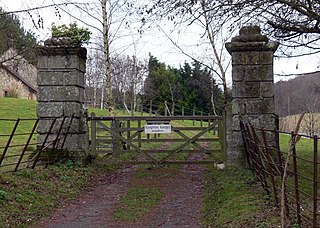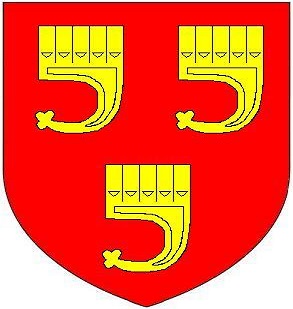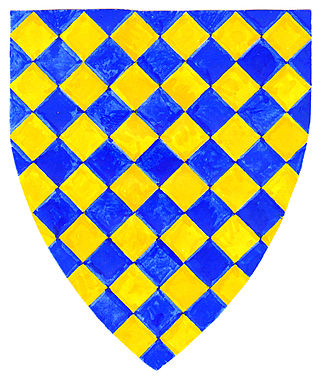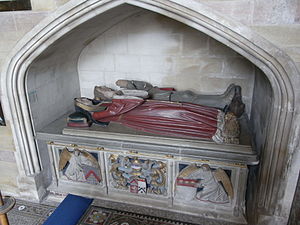
Caerlaverock Castle is a moated triangular castle first built in the 13th century. It is located on the southern coast of Scotland, eleven kilometres south of Dumfries, on the edge of the Caerlaverock National Nature Reserve. Caerlaverock was a stronghold of the Maxwell family from the 13th century until the 17th century, when the castle was abandoned. It was besieged by the English during the Wars of Scottish Independence, and underwent several partial demolitions and reconstructions over the 14th and 15th centuries. In the 17th century, the Maxwells were created Earls of Nithsdale, and built a new lodging within the walls, described as among "the most ambitious early classical domestic architecture in Scotland". In 1640 the castle was besieged for the last time by the Protestant Covenanter army and was subsequently abandoned. Although demolished and rebuilt several times, the castle retains the distinctive triangular plan first laid out in the 13th century. Caerlaverock Castle was built to control trade in early times.

Henry, 3rd Earl of Leicester and Lancaster was a grandson of King Henry III of England (1216–1272) and was one of the principals behind the deposition of King Edward II (1307–1327), his first cousin.

An abatement is a modification of a coat of arms, representing a less-than honorable augmentation, imposed by an heraldic authority or by royal decree for misconduct. The practice of inverting the entire escutcheon of an armiger found guilty of high treason has been attested since the Middle Ages and is generally accepted as reliable, and medieval heraldic sources cite at least one instance of removing an honourable charge from a coat of arms by royal decree as an abatement of honour. Other abatements of honour implied by the addition of dishonourable stains and charges, appearing in late 16th-century texts, have never been reliably attested in actual practice. Additionally, as many heraldic writers note, the use of arms is not compulsory, so armigers are more likely to relinquish a dishonored coat of arms than to advertise their dishonor.

Kingston Russell House is a large mansion house and manor near Long Bredy in Dorset, England, west of Dorchester. The present house dates from the late 17th century but in 1730 was clad in a white Georgian stone facade. The house was restored in 1913, and at the same time the gardens were laid out.

A roll of arms is a collection of coats of arms, usually consisting of rows of painted pictures of shields, each shield accompanied by the name of the person bearing the arms.
In heraldry and heraldic vexillology, a blazon is a formal description of a coat of arms, flag or similar emblem, from which the reader can reconstruct the appropriate image. The verb to blazon means to create such a description. The visual depiction of a coat of arms or flag has traditionally had considerable latitude in design, but a verbal blazon specifies the essentially distinctive elements. A coat of arms or flag is therefore primarily defined not by a picture but rather by the wording of its blazon. Blazon is also the specialized language in which a blazon is written, and, as a verb, the act of writing such a description. Blazonry is the art, craft or practice of creating a blazon. The language employed in blazonry has its own vocabulary, grammar and syntax, which becomes essential for comprehension when blazoning a complex coat of arms.
Maurice FitzThomas FitzGerald, 4th Earl of Kildare was a prominent Irish nobleman in the Peerage of Ireland who held the office of Lord Justice of Ireland.

The Gorges family was a gentry family established in the southwest of England.

Sir Maurice Russell, JP of Kingston Russell, Dorset and Dyrham, Glos. was an English gentleman and knight. He was a prominent member of the Gloucestershire gentry. He was the third but eldest surviving son and heir of Sir Ralph Russell (1319–1375) and his wife Alice. He was knighted between June and December 1385 and served twice as Knight of the Shire for Gloucestershire in 1402 and 1404. He held the post of Sheriff of Gloucestershire four times, and was Coroner and Justice of the Peace, Tax Collector and Commissioner of Enquiry. His land holdings were extensive in Gloucestershire, Somerset, Dorset, Berkshire and Buckinghamshire. He was descended from an ancient line which can be traced back to 1210, which ended on the death of his son Thomas, from his second marriage, as a young man without male issue. Most of his estates, despite having been entailed, passed at his death into the families of his two daughters from his first marriage.

Sir William Russell (1257–1311) was an English nobleman, knight, and holder of a moiety of the feudal barony of North Cadbury, Somerset, but spent most of his life engaged in the administration and defence of the Isle of Wight, where he obtained by marriage the manor of Yaverland. He served as constable of Carisbrooke Castle, and sat in parliament on two occasions, firstly as burgess for Great Bedwyn, Wiltshire, and then for the County of Southampton. As a baron his military service was called on several times by King Edward I Hammer of the Scots.

Maurice Denys, Esquire, of Siston, Gloucestershire, was twice Sheriff of Gloucestershire in 1460 and 1461. The Denys family were stated by Sir Robert Atkyns, the 18th-century historian of Gloucestershire, to have provided more sheriffs for that county than any other family.

Jessant-de-lys is a heraldic term denoting a fleur-de-lys issuing out of any object. It is most frequently seen in conjunction with a leopard's face, meaning in heraldic language the face of a lion.

Knighton Gorges Manor was one of the grandest manor houses on the Isle of Wight, located in the hamlet of Knighton, near Newchurch.

The Denys monumental brass in Olveston Church, Gloucestershire, dates from 1505, and is one of only about 80 surviving monumental brasses in Gloucestershire. It was erected following the death of Sir Walter Denys in 1505, and shows the latter together with his father Maurice Denys, both Sheriffs of Gloucestershire. The Denys family were at various times lords of the manors of Alveston, Earthcott Green, Siston and Dyrham in Gloucestershire.
The Manor of Dyrham was a former manorial estate in the parish of Dyrham in South Gloucestershire, England.

The flag of Surrey is the blue and gold chequered flag of the traditional county of Surrey and is derived from the coat of arms of William de Warenne, 2nd Earl of Surrey who adopted arms similar of the Capetian Count of Vermandois on his marriage to Elizabeth, Countess of Leicester, who was first married to Robert de Beaumont, 1st Earl of Leicester. She was a younger daughter of Hugh I, Count of Vermandois (1057–1102). Similar arms were also adopted by his brother in law, Ralph I de Beaugency, who married Hugh I's oldest daughter, Matilda. (heraldic blazon: Chequy Or and Azur).

The manor of Bideford in North Devon was held by the Grenville family between the 12th and 18th centuries. The full descent is as follows:
Budockshed is a historic estate in the parish of St Budeaux, near Plymouth in Devon, England.

The coat of arms of the Prince of Wales is the official personal heraldic insignia of the Princes of Wales, a title traditionally granted to the heir apparent of the reigning monarch of the United Kingdom of Great Britain and Northern Ireland, formerly the Kingdom of Great Britain and before that the Kingdom of England.

Baron Gorges was a title created in the Peerage of England for the soldier Sir Ralph Gorges, of Wraxall in Somerset, who was summoned to Parliament as a baron in 1309. On the death of his son without children in 1344, any hereditary title expired.























